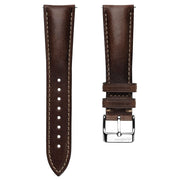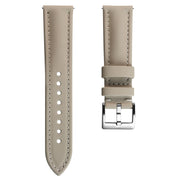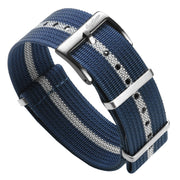Creating a watch movement is a complex endeavour and, at least within the Swiss watch industry, a few major companies (such as ETA, Sellita, and Ronda) produce the vast majority of watch movements. The reliable ETA 2824, for example, introduced in the early 1970s, has been a staple of the industry and is still widely used in its various iterations by numerous watch brands.

While major movements manufacturers dominate the watchmaking landscape, a select group of small Swiss workshops quietly develop the intricate movements powering some of the world's most exclusive watches. Due to stringent confidentiality agreements, their remarkable craftsmanship and groundbreaking innovations are largely confined to the knowledge of watch industry professionals, though their impact on high horology is irrefutable.
So, let’s explore three of the most pivotal companies in the world of niche watch movements.
Niche Watch Movements
Chronode SA Watch Movements
I was genuinely surprised to discover that many of my favourite high horology watches actually originated from a single workshop based in Le Locle: Chronode SA, under the direction of Jean-François Mojon. After holding various roles at IWC, including head of Research and Development, he founded Chronode SA in 2005, at a time when demand for unconventional and innovative watch movements was really high.
In the past 20 years, Chronode SA has delivered over one hundred watchmaking developments for prestigious brands, including Harry Winston, Hermès, MB&F, Czapek, HYT, Cyrus, and many more.
HYT H1: The First Hydro-Mechanical Watch
Born from a collaboration between HYT and Chronode and released in 2012, the HYT H1 displays the hours using fluid rather than hands. The key challenge was to integrate the mechanical movement and fluidic system while creating a seamless interface between them. The tube contains two immiscible fluids (one water-based and the other oil-based), and the movement includes a temperature compensation mechanism to prevent fluid contraction or expansion over time. HYT is the only watch brand using fluid to indicate time.
Harry Winston Opus X (Opus 10): The Mini Solar System

Released in 2010, the Opus 10 was a collaboration between Harry Winston and Chronode. The watch features a unique display of hours, minutes, and a second time zone on individual discs instead of hands. The movement is based on a planetary gear train, functioning like a miniature solar system. The dial rotates once every 24 hours, while the individual discs rotate counterclockwise to maintain their upward orientation. A power reserve indicator is located on the back of the movement.
Notably, Chronode SA also used a similar planetary system to develop the Hermès Arceau L’Heure De La Lune, which won the 2019 GPHG Calendar and Astronomy Award.
Agenhor Watch Movements
Agenhor, short for "Atelier Genevois Horlogerie" (Geneva Watchmaking Workshop), was founded by Jean-Marc and Catherine Wiederrecht in 1996. The company has developed numerous movements for high-end brands such as Hermès, Parmigiani Fleurier, H. Moser & Cie., Fabergé, Ming, and Singer.
Jean-Marc Wiederrecht, as an independent watchmaker, has developed a focus on improving legibility for complications like perpetual calendars and chronographs over his career. His breakthrough piece was a bi-retrograde perpetual calendar developed in partnership with Roger Dubuis in the late 1980s, which significantly improved the readability of the day and date compared to traditional perpetual calendars. Another major achievement was the AgenGraphe, which reinvented the chronograph display. Agenhor is now led by Laurent and Nicolas Wiederrecht, the next generation of the family.
Hermès Le Temps Suspendu: The Watch That Suspends Time


Agenhor came up with a really unique and poetic complication for this watch, though it does the opposite of what a complication usually does—it takes away a function. Imagine you're enjoying a special moment and don't want to track time anymore. Use the pusher, and the hands move to almost twelve o'clock, effectively suspending time. Even though the hands stop moving, the watch keeps running in the background. When you're ready, another use of the pusher brings the hands back to the current time.
At Watches and Wonders 2025 Hermès revived the Arceau "Le temps suspendu", powered by the Manufacture Hermès H1837 movement.
Singer - Track 1: The Reinvented Chronograph
A common issue with chronographs is poor legibility. The Singer - Track 1, equipped with the AgenGraphe movement, addresses this by inverting the traditional chronograph display. Instead of displaying the time, the three main hands indicate chronograph seconds, minutes, and hours, while the current time is shown on two peripheral rotating discs, significantly improving legibility.
Another innovation is the hidden rotor, which provides a full view of the movement. The chronograph also features the innovative Agenclutch, which combines the advantages of traditional horizontal and vertical clutches.
Complitime SA Watch Movements
Complitime SA was founded by Robert Greubel and Stephen Forsey. Robert is French, and Stephen is British; they met while working at Renaud & Papi SA (now Audemars Piguet Renaud & Papi SA). They created CompliTime in 2001 and their own brand, Greubel Forsey, in 2004.
While Greubel Forsey is their primary focus, CompliTime continues to operate as a subsidiary, developing movements for the most prestigious brands, including Richard Mille and Harry Winston. Though CompliTime keeps its clients confidential, Richemont's minority stake suggests they likely utilise CompliTime for developing complex watches, possibly for brands like Vacheron Constantin.
Harry Winston Histoire de Tourbillons 10: The Record-Breaking Watch

The Harry Winston Histoire de Tourbillons 10 is a remarkable watch. While a single tourbillon is exceptional, this watch features four tourbillons, each rotating every 36 seconds at 3Hz. Three differentials are used to equalize the tourbillons' rates. As you can guess, this complex watch requires significant energy, which is provided by two double barrels delivering a 55-hour power reserve. It comprises 673 components and measures 53mm x 39mm x 17.6mm. While its practical purpose may be debated, it is undoubtedly a feat of engineering.
Greubel Forsey Nano Foudroyante EWT: Nanomechanics in Watchmaking


EWT stands for Experimental Watch Technology, and the Nano Foudroyante EWT incorporates "nanomechanics", or component miniaturisation. This miniaturisation significantly improves energy management, as demonstrated by the foudroyante complication.
By reducing the foudroyante mechanism's volume by 90% through the elimination of the traditional gear train, energy consumption is reduced from 18.30 μJ (microjoules) to 16 nJ (nanojoules) per jump, a 1,800-fold decrease. This is a substantial improvement for such an energy-intensive complication.
This watch, featuring 428 components, includes a foudroyante, flying tourbillon, and flyback chronograph, while measuring only 37.9mm x 10.5mm. While this watch demonstrates a proof of concept, the pursuit of 'nanomechanics' could pave the way for substantial developments in the future.
For those who prefer to keep things a little simpler, don’t forget to check out our guide to the most popular watch movements in modern horology.








